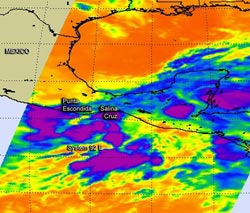NASA Sees Developing Tropical Cyclone Near Southwestern Mexico

NASA’s Aqua satellite flew over System 92E in the eastern Pacific Ocean on May 28 at 07:17 UTC (3:17 a.m. EDT) and captured this infrared image of the storm. The purple areas indicate the coldest cloud top temperatures and strongest storms. Credit: NASA JPL, Ed Olsen<br>
System 92E may organize more and become Tropical Storm Barbara later on May 28 as it continues organizing near the southwestern Mexican coast. When NASA’s Aqua satellite flew over System 92E on May 28 at 07:17 UTC (3:17 a.m. EDT), the Atmospheric Infrared Sounder (AIRS) instrument aboard Aqua captured an infrared image of the storm.
AIRS measured cloud top temperatures as cold as -63 Fahrenheit (-52 Celsius), that were indicative of high, strong thunderstorms with the potential to drop heavy rain. Those storms stretched over open waters west of Punta Escondida southward to Salina Cruz.
System 92E appears almost stationary, and the National Hurricane Center (NHC) expects the low to continue consolidating. Shower and thunderstorm activity continues to gradually increase today, May 28. System 92E’s center is about 200 miles south of Salina Cruz, Mexico.
The NHC expects System 92E to become Tropical Storm Barbara late in the day on May 28, before it makes landfall later along the southwestern coast of Mexico. Tropical Storm Warnings could be posted later in the day and heavy rains are expected over southern Mexico and western Central America during the next few days.
Text credit: Rob Gutro
NASA’s Goddard Space Flight Center
Media Contact
All latest news from the category: Earth Sciences
Earth Sciences (also referred to as Geosciences), which deals with basic issues surrounding our planet, plays a vital role in the area of energy and raw materials supply.
Earth Sciences comprises subjects such as geology, geography, geological informatics, paleontology, mineralogy, petrography, crystallography, geophysics, geodesy, glaciology, cartography, photogrammetry, meteorology and seismology, early-warning systems, earthquake research and polar research.
Newest articles

“Nanostitches” enable lighter and tougher composite materials
In research that may lead to next-generation airplanes and spacecraft, MIT engineers used carbon nanotubes to prevent cracking in multilayered composites. To save on fuel and reduce aircraft emissions, engineers…

Trash to treasure
Researchers turn metal waste into catalyst for hydrogen. Scientists have found a way to transform metal waste into a highly efficient catalyst to make hydrogen from water, a discovery that…

Real-time detection of infectious disease viruses
… by searching for molecular fingerprinting. A research team consisting of Professor Kyoung-Duck Park and Taeyoung Moon and Huitae Joo, PhD candidates, from the Department of Physics at Pohang University…




















